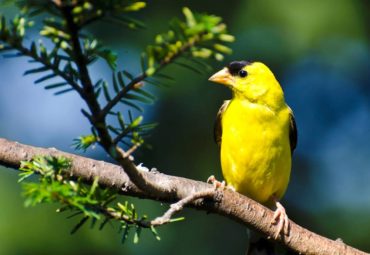
Yellow birds, or those that are almost all yellow, are rare in the Pacific Northwest but there is more than one species. The American goldfinch, state bird for Washington, is the best known and the easiest to recognize. Small numbers visit feeding stations during the winter months but are easy to miss.
Their less-colorful winter plumage allows them to blend into pine siskin flocks. The two species are closely related and often travel together when they aren’t nesting.
Most of the male goldfinch’s plumage is yellow. He has a black cap on his forehead and his wings are black and white. Nonbreeding males resemble the female and lack the bright-yellow coloring.
One of the goldfinch’s popular nicknames is “wild canary.” They nest later in the summer when the wild thistles have gone to seed. “Thistle milk” consists of partially digested thistle seeds regurgitated by the adults. This is the first nourishment fed to the newly hatched young.
Among the yellow birds seen throughout the West Sound region is the yellow warbler. It’s a small bird but it has a big voice. Several field guides describe its song as “sweet, high, clear notes, sharply slurred upward and then sharply slurred downward.” It ends with a rollicking, “sweet, sweet, sweet, ti-ti-wee!”
The male is all yellow but has several narrow, chestnut-colored stripes on his breast. The female is all yellow. Like other warbler species, this bird is seen foraging among the blossoms on fruit trees and other flowering plants. Primarily an insect-eating bird, it arrives in the Northwest in May.
Wilson’s warbler is another yellow bird that arrives in May. Its presence is often discovered because of its voice. While the Wilson’s are feeding in thickets of deciduous plants, they communicate nonstop. Their call is a sharp, quick “chet-chet-chet-chet!” They move quickly but their voice and their bright coloring give them away.
The male is a deep yellow over most of his body. His crown or cap is black. The female is a pale version and can have a pale brown hint of a cap. They are found in damp areas where the wild roses, elderberry and salmonberry grow and where the insect population is abundant. They also arrive in this area in May.
Yellow is the predominant color for the Western tanager’s plumage. Waves of these birds flood into the Northwest during May. Their song is melodic and similar to the robin’s.
They are larger than the finches and warblers and are recognized by their brilliant coloring and heavy pale-colored bills. The male is a rich yellow color and has a reddish forehead. His wings are black and white.
The female is an overall greenish-yellow color. Tanagers can be difficult to find as they move throughout the deciduous trees and bushes. Despite their yellow coloring, they easily disappear in the shady dappling found on green, leafy trees.
May is the month when the West Sound’s yellow birds arrive for the summer. Many will stay to nest in the habitat of their choice. Some will continue northward and others will move to the higher elevations found in the foothills and mountains.
Listening for their voices is the best way to know they are present. Their brilliant coloring makes them easy to identify.
























